Dimensions and Antecedents of OCB: A Literature Review
VerifiedAdded on 2020/04/13
|8
|2198
|115
Essay
AI Summary
This essay provides a comprehensive overview of Organizational Citizenship Behavior (OCB), exploring its dimensions and antecedents. It begins by defining OCB as voluntary behaviors exceeding job requirements, linking it to productivity, employee effectiveness, and long-term business impacts. A literature review examines the influence of job satisfaction, social exchange theory, and OCB's role in organizational effectiveness. The essay identifies key dimensions of OCB, including sportsmanship, altruism, civic virtue, conscientiousness, and courtesy, with examples illustrating each. It also discusses the antecedents, such as job satisfaction and organizational justice, and their impact on employee behavior. The essay references numerous studies and provides a well-rounded understanding of OCB and its significance in the workplace.
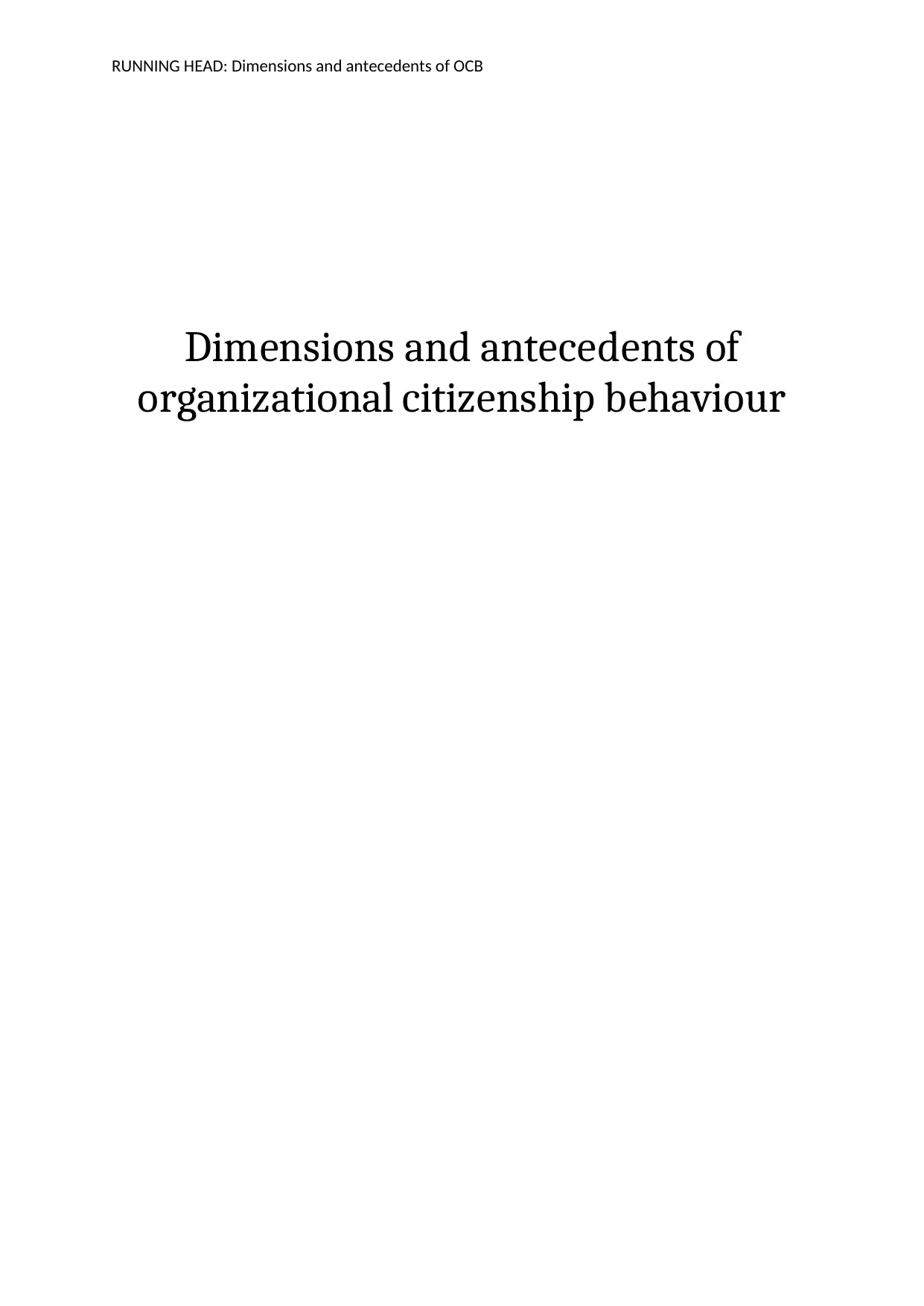
RUNNING HEAD: Dimensions and antecedents of OCB
Dimensions and antecedents of
organizational citizenship behaviour
Dimensions and antecedents of
organizational citizenship behaviour
Paraphrase This Document
Need a fresh take? Get an instant paraphrase of this document with our AI Paraphraser
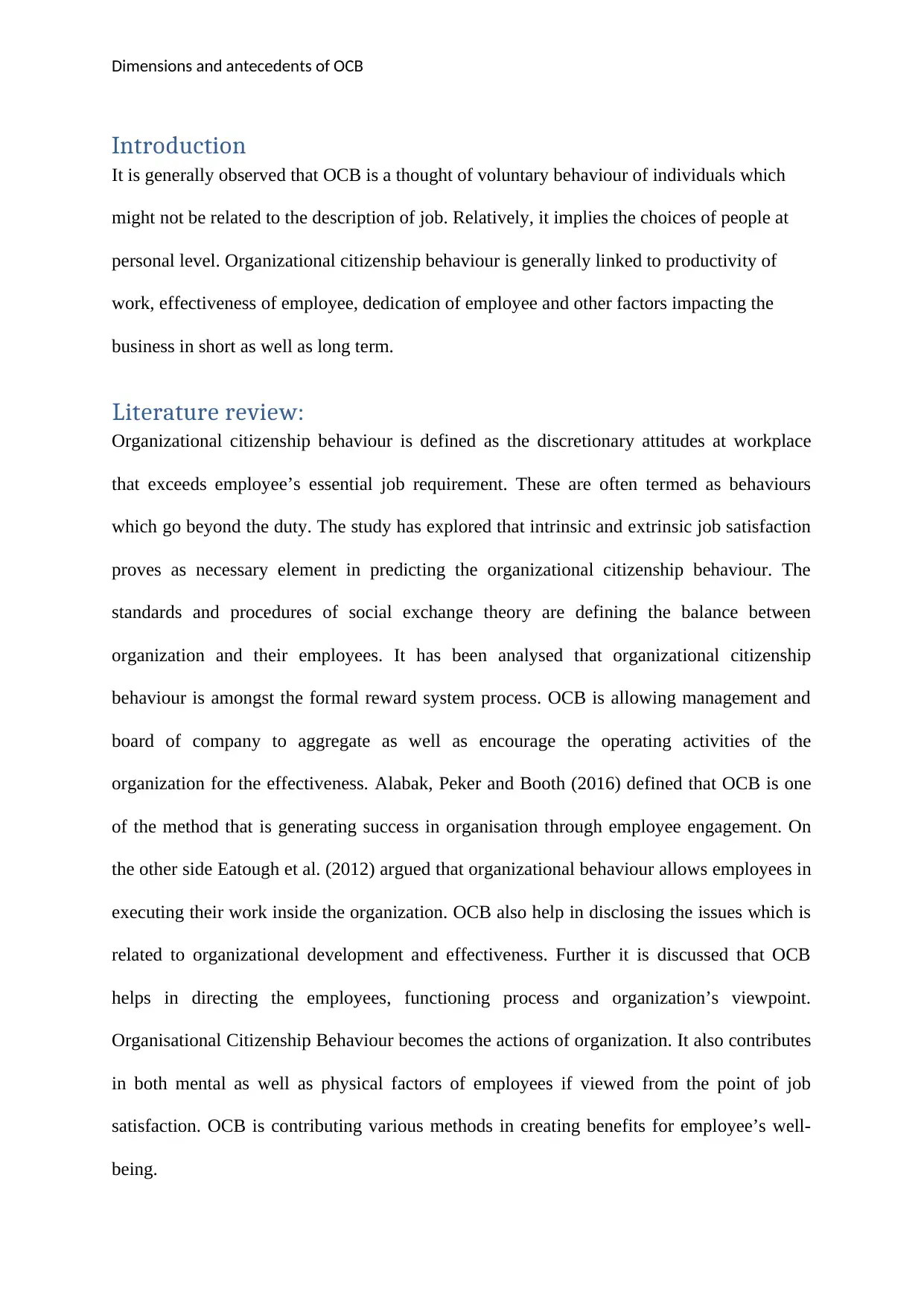
Dimensions and antecedents of OCB
Introduction
It is generally observed that OCB is a thought of voluntary behaviour of individuals which
might not be related to the description of job. Relatively, it implies the choices of people at
personal level. Organizational citizenship behaviour is generally linked to productivity of
work, effectiveness of employee, dedication of employee and other factors impacting the
business in short as well as long term.
Literature review:
Organizational citizenship behaviour is defined as the discretionary attitudes at workplace
that exceeds employee’s essential job requirement. These are often termed as behaviours
which go beyond the duty. The study has explored that intrinsic and extrinsic job satisfaction
proves as necessary element in predicting the organizational citizenship behaviour. The
standards and procedures of social exchange theory are defining the balance between
organization and their employees. It has been analysed that organizational citizenship
behaviour is amongst the formal reward system process. OCB is allowing management and
board of company to aggregate as well as encourage the operating activities of the
organization for the effectiveness. Alabak, Peker and Booth (2016) defined that OCB is one
of the method that is generating success in organisation through employee engagement. On
the other side Eatough et al. (2012) argued that organizational behaviour allows employees in
executing their work inside the organization. OCB also help in disclosing the issues which is
related to organizational development and effectiveness. Further it is discussed that OCB
helps in directing the employees, functioning process and organization’s viewpoint.
Organisational Citizenship Behaviour becomes the actions of organization. It also contributes
in both mental as well as physical factors of employees if viewed from the point of job
satisfaction. OCB is contributing various methods in creating benefits for employee’s well-
being.
Introduction
It is generally observed that OCB is a thought of voluntary behaviour of individuals which
might not be related to the description of job. Relatively, it implies the choices of people at
personal level. Organizational citizenship behaviour is generally linked to productivity of
work, effectiveness of employee, dedication of employee and other factors impacting the
business in short as well as long term.
Literature review:
Organizational citizenship behaviour is defined as the discretionary attitudes at workplace
that exceeds employee’s essential job requirement. These are often termed as behaviours
which go beyond the duty. The study has explored that intrinsic and extrinsic job satisfaction
proves as necessary element in predicting the organizational citizenship behaviour. The
standards and procedures of social exchange theory are defining the balance between
organization and their employees. It has been analysed that organizational citizenship
behaviour is amongst the formal reward system process. OCB is allowing management and
board of company to aggregate as well as encourage the operating activities of the
organization for the effectiveness. Alabak, Peker and Booth (2016) defined that OCB is one
of the method that is generating success in organisation through employee engagement. On
the other side Eatough et al. (2012) argued that organizational behaviour allows employees in
executing their work inside the organization. OCB also help in disclosing the issues which is
related to organizational development and effectiveness. Further it is discussed that OCB
helps in directing the employees, functioning process and organization’s viewpoint.
Organisational Citizenship Behaviour becomes the actions of organization. It also contributes
in both mental as well as physical factors of employees if viewed from the point of job
satisfaction. OCB is contributing various methods in creating benefits for employee’s well-
being.
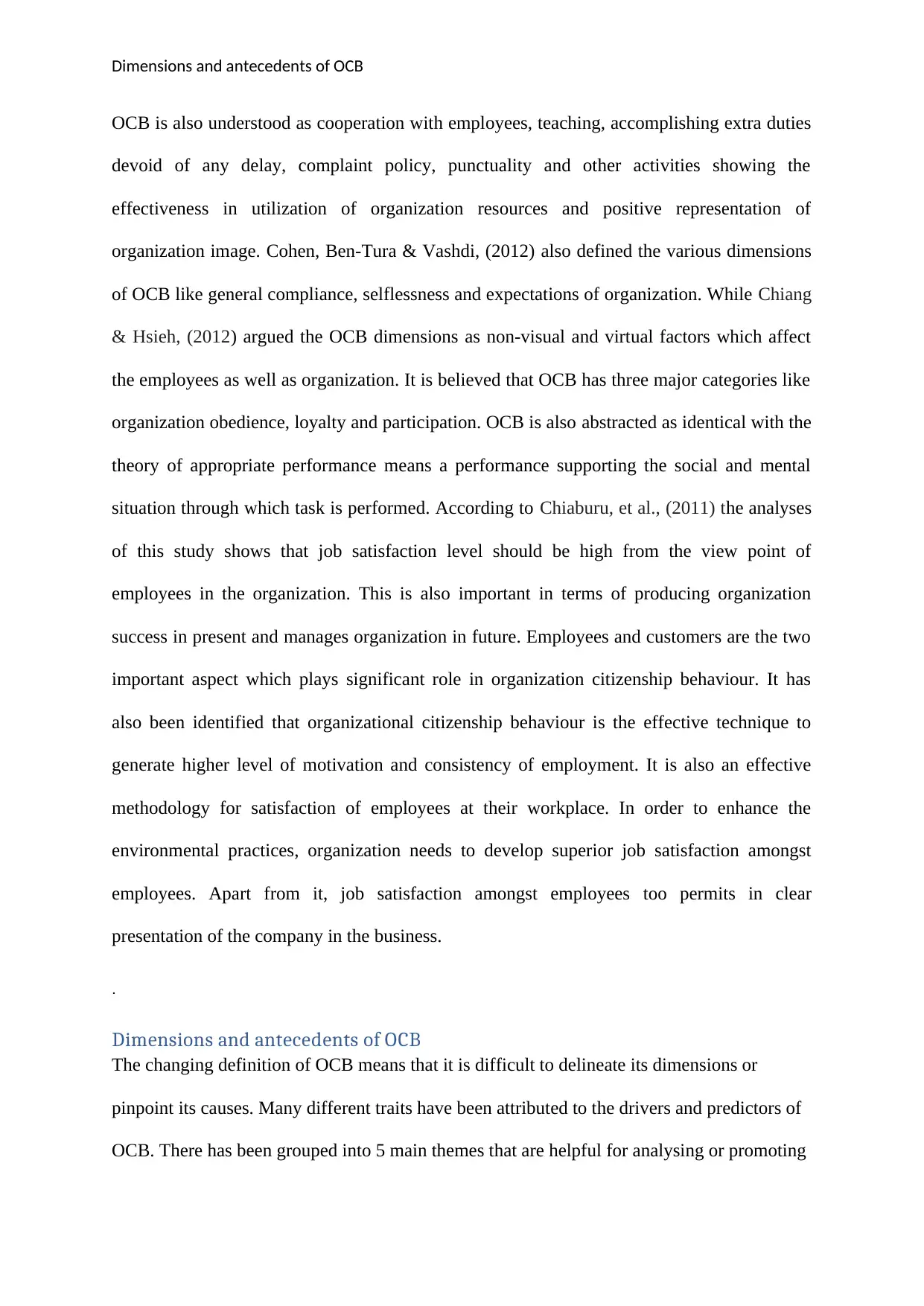
Dimensions and antecedents of OCB
OCB is also understood as cooperation with employees, teaching, accomplishing extra duties
devoid of any delay, complaint policy, punctuality and other activities showing the
effectiveness in utilization of organization resources and positive representation of
organization image. Cohen, Ben-Tura & Vashdi, (2012) also defined the various dimensions
of OCB like general compliance, selflessness and expectations of organization. While Chiang
& Hsieh, (2012) argued the OCB dimensions as non-visual and virtual factors which affect
the employees as well as organization. It is believed that OCB has three major categories like
organization obedience, loyalty and participation. OCB is also abstracted as identical with the
theory of appropriate performance means a performance supporting the social and mental
situation through which task is performed. According to Chiaburu, et al., (2011) the analyses
of this study shows that job satisfaction level should be high from the view point of
employees in the organization. This is also important in terms of producing organization
success in present and manages organization in future. Employees and customers are the two
important aspect which plays significant role in organization citizenship behaviour. It has
also been identified that organizational citizenship behaviour is the effective technique to
generate higher level of motivation and consistency of employment. It is also an effective
methodology for satisfaction of employees at their workplace. In order to enhance the
environmental practices, organization needs to develop superior job satisfaction amongst
employees. Apart from it, job satisfaction amongst employees too permits in clear
presentation of the company in the business.
.
Dimensions and antecedents of OCB
The changing definition of OCB means that it is difficult to delineate its dimensions or
pinpoint its causes. Many different traits have been attributed to the drivers and predictors of
OCB. There has been grouped into 5 main themes that are helpful for analysing or promoting
OCB is also understood as cooperation with employees, teaching, accomplishing extra duties
devoid of any delay, complaint policy, punctuality and other activities showing the
effectiveness in utilization of organization resources and positive representation of
organization image. Cohen, Ben-Tura & Vashdi, (2012) also defined the various dimensions
of OCB like general compliance, selflessness and expectations of organization. While Chiang
& Hsieh, (2012) argued the OCB dimensions as non-visual and virtual factors which affect
the employees as well as organization. It is believed that OCB has three major categories like
organization obedience, loyalty and participation. OCB is also abstracted as identical with the
theory of appropriate performance means a performance supporting the social and mental
situation through which task is performed. According to Chiaburu, et al., (2011) the analyses
of this study shows that job satisfaction level should be high from the view point of
employees in the organization. This is also important in terms of producing organization
success in present and manages organization in future. Employees and customers are the two
important aspect which plays significant role in organization citizenship behaviour. It has
also been identified that organizational citizenship behaviour is the effective technique to
generate higher level of motivation and consistency of employment. It is also an effective
methodology for satisfaction of employees at their workplace. In order to enhance the
environmental practices, organization needs to develop superior job satisfaction amongst
employees. Apart from it, job satisfaction amongst employees too permits in clear
presentation of the company in the business.
.
Dimensions and antecedents of OCB
The changing definition of OCB means that it is difficult to delineate its dimensions or
pinpoint its causes. Many different traits have been attributed to the drivers and predictors of
OCB. There has been grouped into 5 main themes that are helpful for analysing or promoting
⊘ This is a preview!⊘
Do you want full access?
Subscribe today to unlock all pages.

Trusted by 1+ million students worldwide
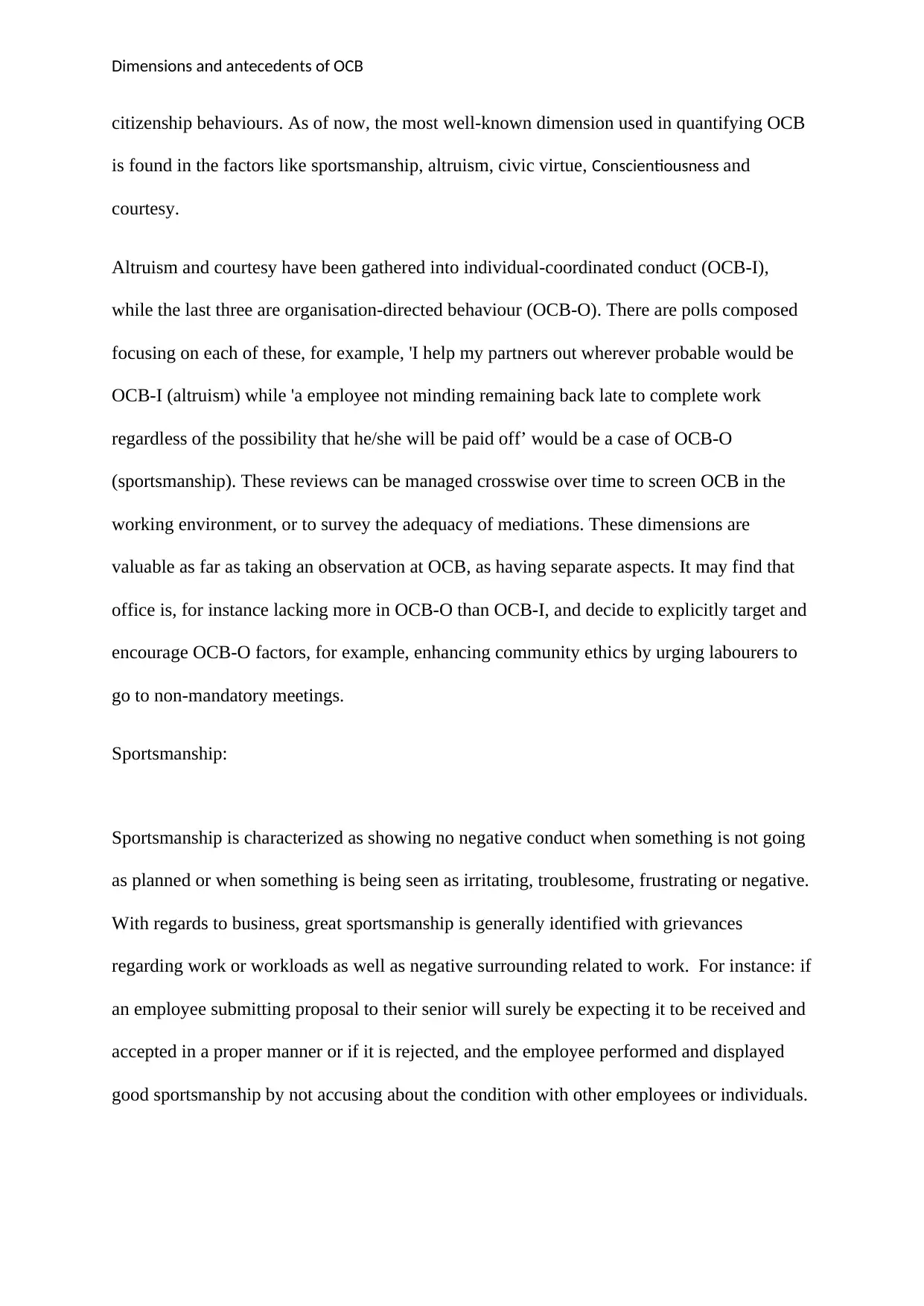
Dimensions and antecedents of OCB
citizenship behaviours. As of now, the most well-known dimension used in quantifying OCB
is found in the factors like sportsmanship, altruism, civic virtue, Conscientiousness and
courtesy.
Altruism and courtesy have been gathered into individual-coordinated conduct (OCB-I),
while the last three are organisation-directed behaviour (OCB-O). There are polls composed
focusing on each of these, for example, 'I help my partners out wherever probable would be
OCB-I (altruism) while 'a employee not minding remaining back late to complete work
regardless of the possibility that he/she will be paid off’ would be a case of OCB-O
(sportsmanship). These reviews can be managed crosswise over time to screen OCB in the
working environment, or to survey the adequacy of mediations. These dimensions are
valuable as far as taking an observation at OCB, as having separate aspects. It may find that
office is, for instance lacking more in OCB-O than OCB-I, and decide to explicitly target and
encourage OCB-O factors, for example, enhancing community ethics by urging labourers to
go to non-mandatory meetings.
Sportsmanship:
Sportsmanship is characterized as showing no negative conduct when something is not going
as planned or when something is being seen as irritating, troublesome, frustrating or negative.
With regards to business, great sportsmanship is generally identified with grievances
regarding work or workloads as well as negative surrounding related to work. For instance: if
an employee submitting proposal to their senior will surely be expecting it to be received and
accepted in a proper manner or if it is rejected, and the employee performed and displayed
good sportsmanship by not accusing about the condition with other employees or individuals.
citizenship behaviours. As of now, the most well-known dimension used in quantifying OCB
is found in the factors like sportsmanship, altruism, civic virtue, Conscientiousness and
courtesy.
Altruism and courtesy have been gathered into individual-coordinated conduct (OCB-I),
while the last three are organisation-directed behaviour (OCB-O). There are polls composed
focusing on each of these, for example, 'I help my partners out wherever probable would be
OCB-I (altruism) while 'a employee not minding remaining back late to complete work
regardless of the possibility that he/she will be paid off’ would be a case of OCB-O
(sportsmanship). These reviews can be managed crosswise over time to screen OCB in the
working environment, or to survey the adequacy of mediations. These dimensions are
valuable as far as taking an observation at OCB, as having separate aspects. It may find that
office is, for instance lacking more in OCB-O than OCB-I, and decide to explicitly target and
encourage OCB-O factors, for example, enhancing community ethics by urging labourers to
go to non-mandatory meetings.
Sportsmanship:
Sportsmanship is characterized as showing no negative conduct when something is not going
as planned or when something is being seen as irritating, troublesome, frustrating or negative.
With regards to business, great sportsmanship is generally identified with grievances
regarding work or workloads as well as negative surrounding related to work. For instance: if
an employee submitting proposal to their senior will surely be expecting it to be received and
accepted in a proper manner or if it is rejected, and the employee performed and displayed
good sportsmanship by not accusing about the condition with other employees or individuals.
Paraphrase This Document
Need a fresh take? Get an instant paraphrase of this document with our AI Paraphraser
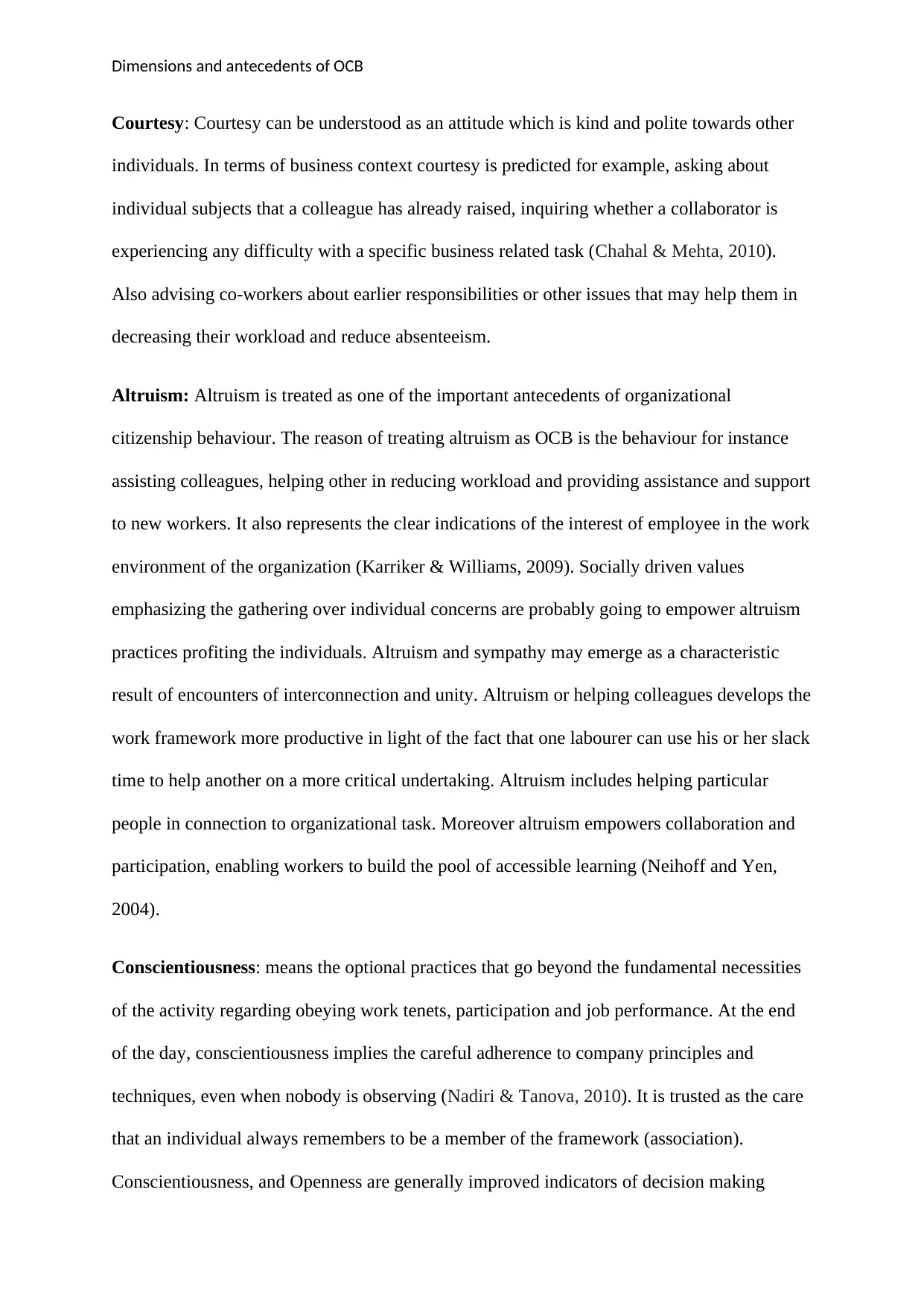
Dimensions and antecedents of OCB
Courtesy: Courtesy can be understood as an attitude which is kind and polite towards other
individuals. In terms of business context courtesy is predicted for example, asking about
individual subjects that a colleague has already raised, inquiring whether a collaborator is
experiencing any difficulty with a specific business related task (Chahal & Mehta, 2010).
Also advising co-workers about earlier responsibilities or other issues that may help them in
decreasing their workload and reduce absenteeism.
Altruism: Altruism is treated as one of the important antecedents of organizational
citizenship behaviour. The reason of treating altruism as OCB is the behaviour for instance
assisting colleagues, helping other in reducing workload and providing assistance and support
to new workers. It also represents the clear indications of the interest of employee in the work
environment of the organization (Karriker & Williams, 2009). Socially driven values
emphasizing the gathering over individual concerns are probably going to empower altruism
practices profiting the individuals. Altruism and sympathy may emerge as a characteristic
result of encounters of interconnection and unity. Altruism or helping colleagues develops the
work framework more productive in light of the fact that one labourer can use his or her slack
time to help another on a more critical undertaking. Altruism includes helping particular
people in connection to organizational task. Moreover altruism empowers collaboration and
participation, enabling workers to build the pool of accessible learning (Neihoff and Yen,
2004).
Conscientiousness: means the optional practices that go beyond the fundamental necessities
of the activity regarding obeying work tenets, participation and job performance. At the end
of the day, conscientiousness implies the careful adherence to company principles and
techniques, even when nobody is observing (Nadiri & Tanova, 2010). It is trusted as the care
that an individual always remembers to be a member of the framework (association).
Conscientiousness, and Openness are generally improved indicators of decision making
Courtesy: Courtesy can be understood as an attitude which is kind and polite towards other
individuals. In terms of business context courtesy is predicted for example, asking about
individual subjects that a colleague has already raised, inquiring whether a collaborator is
experiencing any difficulty with a specific business related task (Chahal & Mehta, 2010).
Also advising co-workers about earlier responsibilities or other issues that may help them in
decreasing their workload and reduce absenteeism.
Altruism: Altruism is treated as one of the important antecedents of organizational
citizenship behaviour. The reason of treating altruism as OCB is the behaviour for instance
assisting colleagues, helping other in reducing workload and providing assistance and support
to new workers. It also represents the clear indications of the interest of employee in the work
environment of the organization (Karriker & Williams, 2009). Socially driven values
emphasizing the gathering over individual concerns are probably going to empower altruism
practices profiting the individuals. Altruism and sympathy may emerge as a characteristic
result of encounters of interconnection and unity. Altruism or helping colleagues develops the
work framework more productive in light of the fact that one labourer can use his or her slack
time to help another on a more critical undertaking. Altruism includes helping particular
people in connection to organizational task. Moreover altruism empowers collaboration and
participation, enabling workers to build the pool of accessible learning (Neihoff and Yen,
2004).
Conscientiousness: means the optional practices that go beyond the fundamental necessities
of the activity regarding obeying work tenets, participation and job performance. At the end
of the day, conscientiousness implies the careful adherence to company principles and
techniques, even when nobody is observing (Nadiri & Tanova, 2010). It is trusted as the care
that an individual always remembers to be a member of the framework (association).
Conscientiousness, and Openness are generally improved indicators of decision making
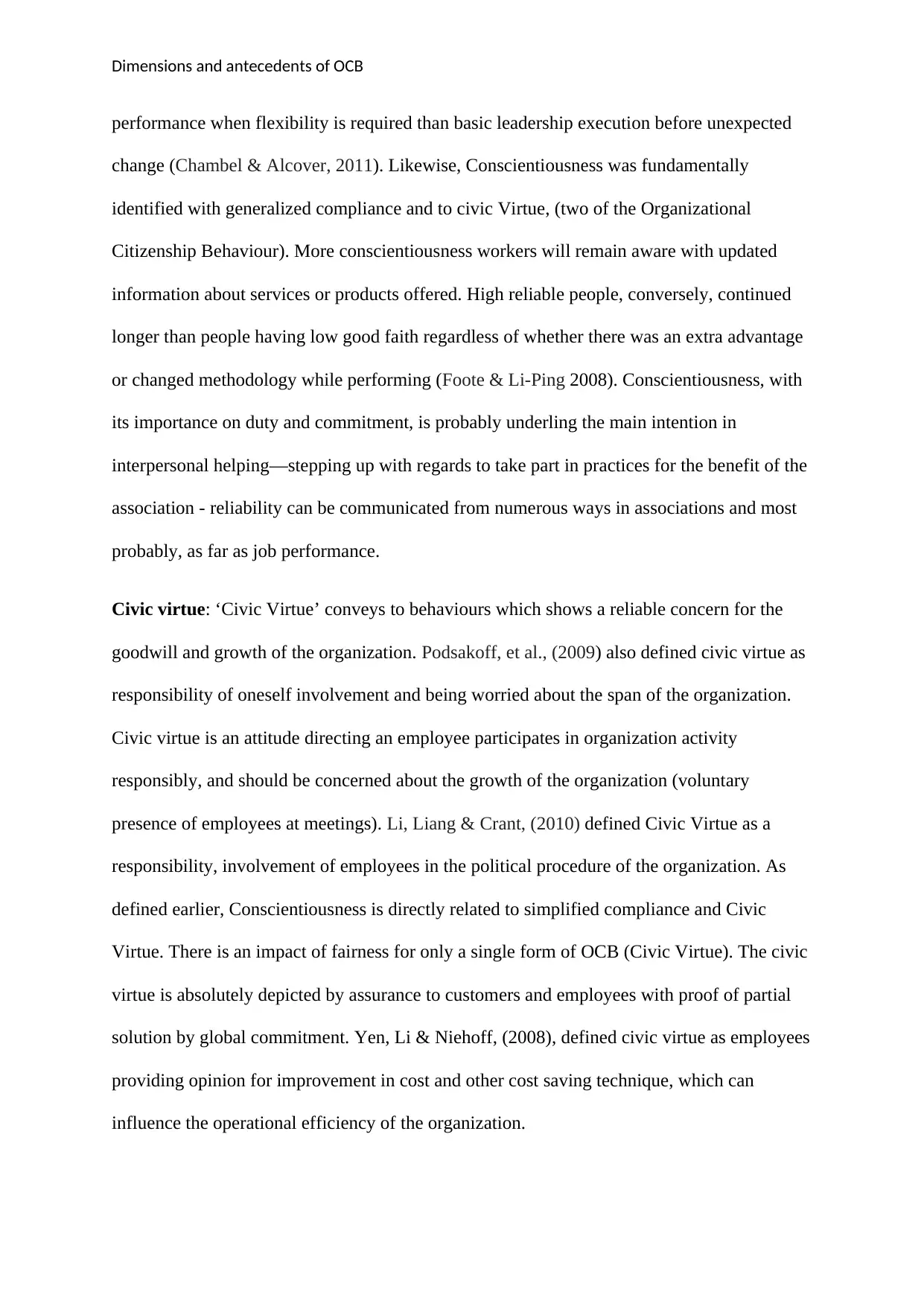
Dimensions and antecedents of OCB
performance when flexibility is required than basic leadership execution before unexpected
change (Chambel & Alcover, 2011). Likewise, Conscientiousness was fundamentally
identified with generalized compliance and to civic Virtue, (two of the Organizational
Citizenship Behaviour). More conscientiousness workers will remain aware with updated
information about services or products offered. High reliable people, conversely, continued
longer than people having low good faith regardless of whether there was an extra advantage
or changed methodology while performing (Foote & Li-Ping 2008). Conscientiousness, with
its importance on duty and commitment, is probably underling the main intention in
interpersonal helping—stepping up with regards to take part in practices for the benefit of the
association - reliability can be communicated from numerous ways in associations and most
probably, as far as job performance.
Civic virtue: ‘Civic Virtue’ conveys to behaviours which shows a reliable concern for the
goodwill and growth of the organization. Podsakoff, et al., (2009) also defined civic virtue as
responsibility of oneself involvement and being worried about the span of the organization.
Civic virtue is an attitude directing an employee participates in organization activity
responsibly, and should be concerned about the growth of the organization (voluntary
presence of employees at meetings). Li, Liang & Crant, (2010) defined Civic Virtue as a
responsibility, involvement of employees in the political procedure of the organization. As
defined earlier, Conscientiousness is directly related to simplified compliance and Civic
Virtue. There is an impact of fairness for only a single form of OCB (Civic Virtue). The civic
virtue is absolutely depicted by assurance to customers and employees with proof of partial
solution by global commitment. Yen, Li & Niehoff, (2008), defined civic virtue as employees
providing opinion for improvement in cost and other cost saving technique, which can
influence the operational efficiency of the organization.
performance when flexibility is required than basic leadership execution before unexpected
change (Chambel & Alcover, 2011). Likewise, Conscientiousness was fundamentally
identified with generalized compliance and to civic Virtue, (two of the Organizational
Citizenship Behaviour). More conscientiousness workers will remain aware with updated
information about services or products offered. High reliable people, conversely, continued
longer than people having low good faith regardless of whether there was an extra advantage
or changed methodology while performing (Foote & Li-Ping 2008). Conscientiousness, with
its importance on duty and commitment, is probably underling the main intention in
interpersonal helping—stepping up with regards to take part in practices for the benefit of the
association - reliability can be communicated from numerous ways in associations and most
probably, as far as job performance.
Civic virtue: ‘Civic Virtue’ conveys to behaviours which shows a reliable concern for the
goodwill and growth of the organization. Podsakoff, et al., (2009) also defined civic virtue as
responsibility of oneself involvement and being worried about the span of the organization.
Civic virtue is an attitude directing an employee participates in organization activity
responsibly, and should be concerned about the growth of the organization (voluntary
presence of employees at meetings). Li, Liang & Crant, (2010) defined Civic Virtue as a
responsibility, involvement of employees in the political procedure of the organization. As
defined earlier, Conscientiousness is directly related to simplified compliance and Civic
Virtue. There is an impact of fairness for only a single form of OCB (Civic Virtue). The civic
virtue is absolutely depicted by assurance to customers and employees with proof of partial
solution by global commitment. Yen, Li & Niehoff, (2008), defined civic virtue as employees
providing opinion for improvement in cost and other cost saving technique, which can
influence the operational efficiency of the organization.
⊘ This is a preview!⊘
Do you want full access?
Subscribe today to unlock all pages.

Trusted by 1+ million students worldwide
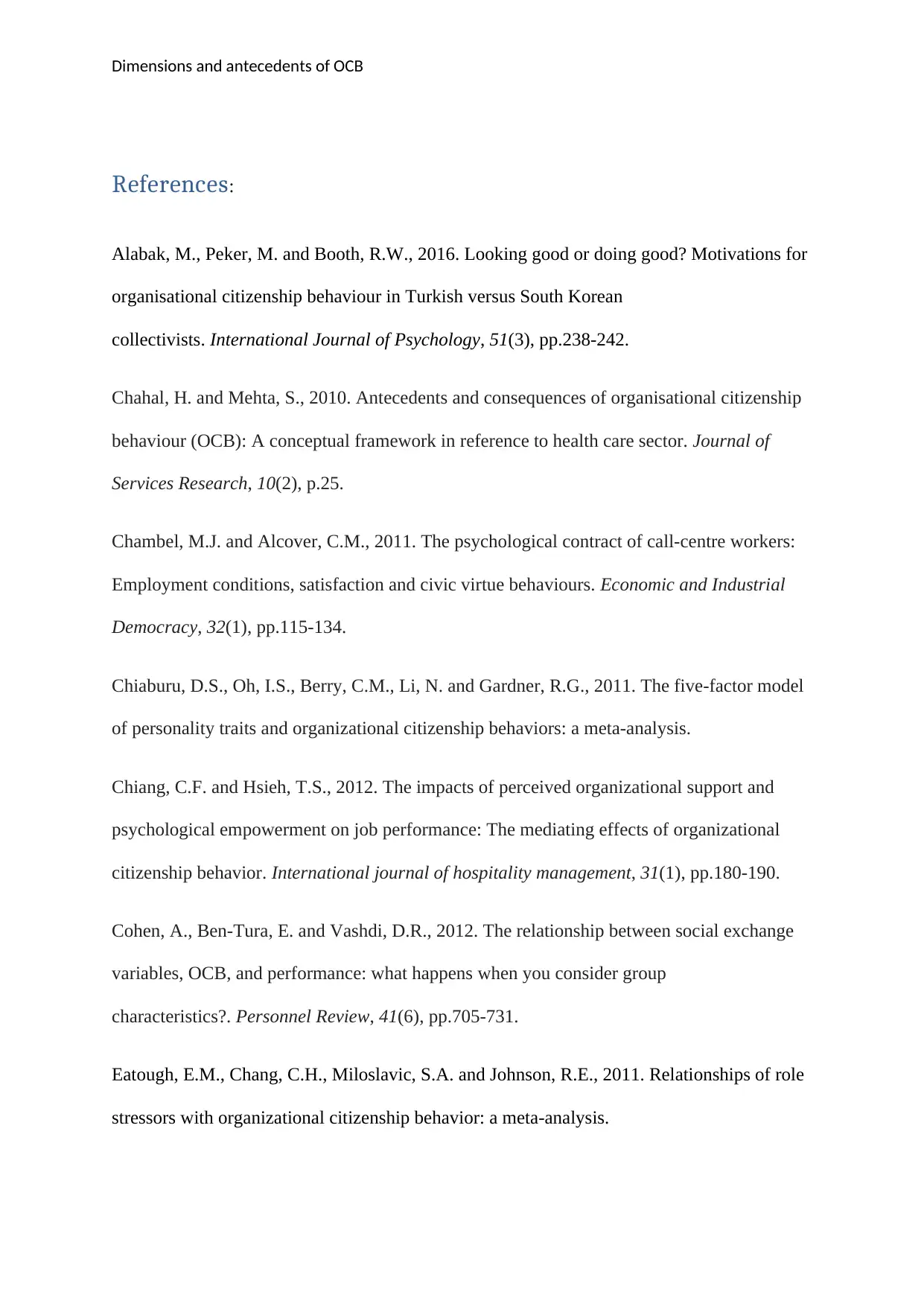
Dimensions and antecedents of OCB
References:
Alabak, M., Peker, M. and Booth, R.W., 2016. Looking good or doing good? Motivations for
organisational citizenship behaviour in Turkish versus South Korean
collectivists. International Journal of Psychology, 51(3), pp.238-242.
Chahal, H. and Mehta, S., 2010. Antecedents and consequences of organisational citizenship
behaviour (OCB): A conceptual framework in reference to health care sector. Journal of
Services Research, 10(2), p.25.
Chambel, M.J. and Alcover, C.M., 2011. The psychological contract of call-centre workers:
Employment conditions, satisfaction and civic virtue behaviours. Economic and Industrial
Democracy, 32(1), pp.115-134.
Chiaburu, D.S., Oh, I.S., Berry, C.M., Li, N. and Gardner, R.G., 2011. The five-factor model
of personality traits and organizational citizenship behaviors: a meta-analysis.
Chiang, C.F. and Hsieh, T.S., 2012. The impacts of perceived organizational support and
psychological empowerment on job performance: The mediating effects of organizational
citizenship behavior. International journal of hospitality management, 31(1), pp.180-190.
Cohen, A., Ben-Tura, E. and Vashdi, D.R., 2012. The relationship between social exchange
variables, OCB, and performance: what happens when you consider group
characteristics?. Personnel Review, 41(6), pp.705-731.
Eatough, E.M., Chang, C.H., Miloslavic, S.A. and Johnson, R.E., 2011. Relationships of role
stressors with organizational citizenship behavior: a meta-analysis.
References:
Alabak, M., Peker, M. and Booth, R.W., 2016. Looking good or doing good? Motivations for
organisational citizenship behaviour in Turkish versus South Korean
collectivists. International Journal of Psychology, 51(3), pp.238-242.
Chahal, H. and Mehta, S., 2010. Antecedents and consequences of organisational citizenship
behaviour (OCB): A conceptual framework in reference to health care sector. Journal of
Services Research, 10(2), p.25.
Chambel, M.J. and Alcover, C.M., 2011. The psychological contract of call-centre workers:
Employment conditions, satisfaction and civic virtue behaviours. Economic and Industrial
Democracy, 32(1), pp.115-134.
Chiaburu, D.S., Oh, I.S., Berry, C.M., Li, N. and Gardner, R.G., 2011. The five-factor model
of personality traits and organizational citizenship behaviors: a meta-analysis.
Chiang, C.F. and Hsieh, T.S., 2012. The impacts of perceived organizational support and
psychological empowerment on job performance: The mediating effects of organizational
citizenship behavior. International journal of hospitality management, 31(1), pp.180-190.
Cohen, A., Ben-Tura, E. and Vashdi, D.R., 2012. The relationship between social exchange
variables, OCB, and performance: what happens when you consider group
characteristics?. Personnel Review, 41(6), pp.705-731.
Eatough, E.M., Chang, C.H., Miloslavic, S.A. and Johnson, R.E., 2011. Relationships of role
stressors with organizational citizenship behavior: a meta-analysis.
Paraphrase This Document
Need a fresh take? Get an instant paraphrase of this document with our AI Paraphraser
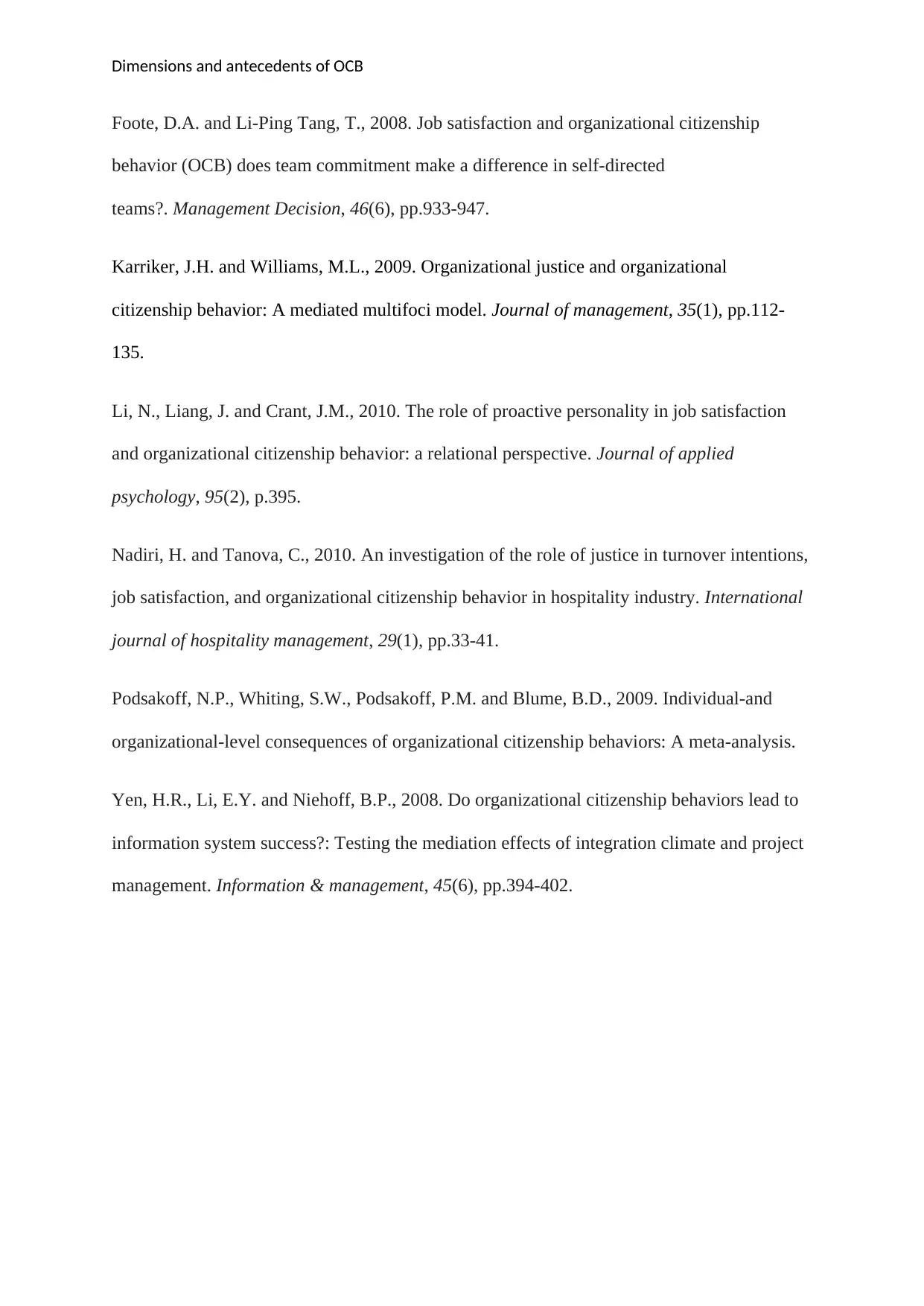
Dimensions and antecedents of OCB
Foote, D.A. and Li-Ping Tang, T., 2008. Job satisfaction and organizational citizenship
behavior (OCB) does team commitment make a difference in self-directed
teams?. Management Decision, 46(6), pp.933-947.
Karriker, J.H. and Williams, M.L., 2009. Organizational justice and organizational
citizenship behavior: A mediated multifoci model. Journal of management, 35(1), pp.112-
135.
Li, N., Liang, J. and Crant, J.M., 2010. The role of proactive personality in job satisfaction
and organizational citizenship behavior: a relational perspective. Journal of applied
psychology, 95(2), p.395.
Nadiri, H. and Tanova, C., 2010. An investigation of the role of justice in turnover intentions,
job satisfaction, and organizational citizenship behavior in hospitality industry. International
journal of hospitality management, 29(1), pp.33-41.
Podsakoff, N.P., Whiting, S.W., Podsakoff, P.M. and Blume, B.D., 2009. Individual-and
organizational-level consequences of organizational citizenship behaviors: A meta-analysis.
Yen, H.R., Li, E.Y. and Niehoff, B.P., 2008. Do organizational citizenship behaviors lead to
information system success?: Testing the mediation effects of integration climate and project
management. Information & management, 45(6), pp.394-402.
Foote, D.A. and Li-Ping Tang, T., 2008. Job satisfaction and organizational citizenship
behavior (OCB) does team commitment make a difference in self-directed
teams?. Management Decision, 46(6), pp.933-947.
Karriker, J.H. and Williams, M.L., 2009. Organizational justice and organizational
citizenship behavior: A mediated multifoci model. Journal of management, 35(1), pp.112-
135.
Li, N., Liang, J. and Crant, J.M., 2010. The role of proactive personality in job satisfaction
and organizational citizenship behavior: a relational perspective. Journal of applied
psychology, 95(2), p.395.
Nadiri, H. and Tanova, C., 2010. An investigation of the role of justice in turnover intentions,
job satisfaction, and organizational citizenship behavior in hospitality industry. International
journal of hospitality management, 29(1), pp.33-41.
Podsakoff, N.P., Whiting, S.W., Podsakoff, P.M. and Blume, B.D., 2009. Individual-and
organizational-level consequences of organizational citizenship behaviors: A meta-analysis.
Yen, H.R., Li, E.Y. and Niehoff, B.P., 2008. Do organizational citizenship behaviors lead to
information system success?: Testing the mediation effects of integration climate and project
management. Information & management, 45(6), pp.394-402.
1 out of 8
Related Documents
Your All-in-One AI-Powered Toolkit for Academic Success.
+13062052269
info@desklib.com
Available 24*7 on WhatsApp / Email
![[object Object]](/_next/static/media/star-bottom.7253800d.svg)
Unlock your academic potential
Copyright © 2020–2025 A2Z Services. All Rights Reserved. Developed and managed by ZUCOL.





